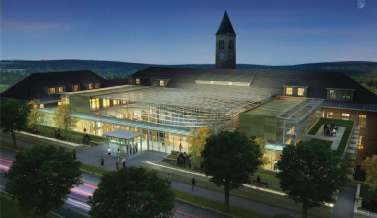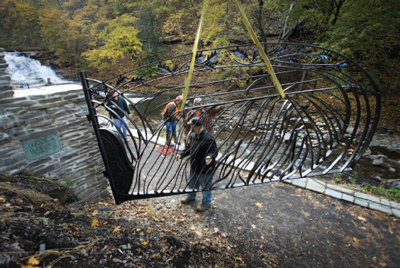University Launches 'Cornell Now! 2015' Campaign; Father Files $180 Million Lawsuit in Gorge Suicide; 2009 Alum is Youngest to Be Elected Mayor of Ithaca; Medical College Names $650 Million Science Facility; New Humanities Space Planned for Arts Quad; Campus Mourns Grad Students; Smits Is Artist of the Year 
River view: The new campus will be on Roosevelt Island, across the water from the Medical school (upper right corner).
Just days after Stanford University—widely seen as its primary rival—dropped out of the competition to build a science and engineering campus in New York City, Cornell was declared the winner. In a press conference held at the Medical college in mid-December, Mayor Michael Bloomberg announced that the city had selected a joint project of Cornell and the Technion, Israel's premier technical institute. "It promises to create a beehive of innovation and discovery," Bloomberg said, "attracting and nurturing the kind of technical talent that will spawn new companies, create new jobs, and propel our city's economy to new frontiers."
The Cornell-Technion plan had emerged as the front runner in the days before the announcement—thanks not only to Stanford's departure, but to the news that the University had secured a $350 million gift from an anonymous donor to support the project. A few hours after the press conference, the New York Times revealed the donor's identity: Charles Feeney '56, who made a fortune with his Duty Free Shoppers stores and went on to give away most of it. Over the years, his Atlantic Philanthropies foundation has donated more than $600 million to Cornell; the $350 million gift brings that total close to an even billion. For decades, Feeney opted to remain anonymous—no Cornell building bears his name—but went public several years ago in the hope that it would inspire other wealthy people to gift their fortunes.
The planned tech campus will be built on the southern end of Roosevelt Island, across the East River from Manhattan and connected to its neighbors via bridge, tram, and subway. The city competition offered free land and up to $100 million in infrastructure improvements; the Cornell-Technion design calls for an eleven-acre campus, partly on the current site of an aging hospital that the city has long planned to demolish. As Bloomberg noted, the project is expected to generate $23 billion in economic benefits and $1.4 billion in tax revenue over the next three decades; its construction will create 20,000 jobs, and 8,000 people will be employed there permanently.
When the project is fully realized—by 2043—it will comprise two million square feet of classroom and research space, plus housing for more than 2,000 students and some 300 faculty. Its programs will begin at an offsite location in fall 2012, with ground broken on Roosevelt Island in 2015 and the first buildings opening no later than 2017. Although there will be no degree programs for undergraduates, the campus could offer them opportunities for research and internships.
In response to a question about the project's possible effect on the Ithaca campus, President David Skorton acknowledged that he understood why people might be concerned. He noted that Cornell has extensive experience with far-flung campuses in locales such as Manhattan and Qatar, that the tech campus would be funded through separate channels as a "pay as you go" operation—and that both the undergrad and grad student assemblies had expressed support for the effort. Skorton also stressed that the project will have educational benefits for K-12 students as well as those from CUNY and SUNY colleges. "This is an exercise in inclusion," Skorton said, "and having all the ships rise in this fine city."
University Launches 'Cornell Now! 2015' Campaign
The University has expanded the goal of its latest capital campaign, raising it to $4.75 billion under an effort dubbed "Cornell Now! 2015." The current "Far Above" campaign, launched in 2006, has garnered $3.3 billion; during the Trustee-Council Annual Meeting in October, President David Skorton announced a new goal of raising an additional $1.45 billion by December 2015. The hoped-for funds include $70 million for faculty renewal and diversity, $157 million for undergraduate scholarships, $100 million for graduate fellowships and professonal school scholarships, and $100 million to advance the University's standing in the humanities and fine arts.
Father Files $180 Million Lawsuit in Gorge Suicide
An alumnus is suing the University for $180 million, alleging that Cornell is responsible for the suicide death of his son. In November, Howard Ginsburg '70 filed suit against Cornell, the City of Ithaca, and several University personnel including President David Skorton. Ginsburg's son, economics major Bradley Ginsburg '13, jumped from the Thurston Avenue Bridge in spring 2010—one of three suicides in the span of several weeks. In the suit, the plaintiff alleges that the defendants "had actual knowledge of the strong likelihood of self-infliction of harm posted by the Thurston Avenue Bridge, due to the long history of gorge-related suicides," but "failed to take obvious steps" to prevent subsequent deaths. Previous lawsuits against Cornell in 1977 and 1981, filed by the parents of students who committed suicide, were unsuccessful.
Following the three suicides, the University erected temporary fences on its bridges, as well as on those adjacent to campus owned by the City of Ithaca. After convening a panel of suicide-prevention experts and exploring various designs for bridge barriers, Cornell opted to replace the fences—which have been criticized as unsightly—with a system of nets. In December, Ithaca's Common Council approved the netting plan; the University aims to begin construction this summer.
2009 Alum is Youngest to Be Elected Mayor of Ithaca

Winning a four-way race with 54 percent of the vote, twenty-four-year-old Svante Myrick '09 has been elected mayor of Ithaca— the youngest person, and the first African American, to hold the position. A former communication major in CALS, Myrick has served on Ithaca's Common Council for four years; he helped create the city's Youth Council and chaired the Collegetown Vision Implementation Committee. The Syracuse-area native was an assistant director of student and young alumni programs in the Office of Alumni Affairs before resigning to run for mayor. Myrick defeated Tompkins County legislator Pam Mackesey '89 in the Democratic primary.
Medical College Names $650 Million Science Facility
In November, the Medical college celebrated the dedication of its $650 million medical sciences facility, announcing that it will be named the Belfer Research Building in honor of donors Robert and Renée Belfer, who gave $100 million. Under construction since spring 2010, the 480,000-square-foot facility on Manhattan's Upper East Side is scheduled to open in 2014. "It will be one of the hallmarks of the twenty-first century for this medical college," outgoing dean Antonio Gotto said at the ceremony. "This will be home to thirty new researchers who will carry out discoveries that we hope will lead to new and improved ways of diagnosing, treating, and curing disease. These new researchers will work with the clinicians in the hospital across the street; they will be mentors and tutors to our medical students, fellows, and residents. So they'll have a big impact on this campus over the succeeding generations."
New Humanities Space Planned for Arts Quad

In October, the University announced it will break ground in summer 2013 for a $61 million addition to Goldwin Smith Hall. The 33,000-square-foot structure— which Cornell is hailing as the first new building dedicated to the humanities in more than a century—will fill the space between Goldwin Smith's wings on the building's eastern side. It will feature a 7,700-square-foot glass atrium, an auditorium, offices, and other program space. Cornell plans to fund the building entirely by philanthropy, including a $25 million lead gift from an anonymous donor. "This spectacular building will symbolically and physically welcome the rest of the campus to participate in the humanities and arts at Cornell," says Arts and Sciences dean Peter Lepage. The new space is projected to open in 2015.

Gorge gateway: A custom-made decorative iron gate has been installed at the lower entrance of the Cascadilla Gorge trail off Linn Street. Created by local artisan Durand Van Doren, who has made similar gates and fences on campus, the 1,200-pound structure will allow the trail to be closed off during hazardous winter conditions.

Photo finish: "Child Holding an Apple" (circa 1860) is on display in Kroch Library as part of an exhibition of early photographs. "Dawn's Early Light: The First 50 Years of American Photography" runs through May 4.
Campus Mourns Grad Students
Two graduate students passed away this fall. Robert Mozia, a twenty-four-year-old from Hackensack, New Jersey, studying biomedical engineering, died of natural causes in late October. Two weeks later, policy analysis and management PhD candidate Kenneth Whelan died suddenly at age twenty-nine; he is survived by a wife and two young sons. The specific causes of the deaths have not been disclosed.
Smits Is Artist of the Year

Actor Jimmy Smits, MFA '82, came to campus in December to accept the Cornell Alumni Artist of the Year Award. Smits is known to TV audiences for his roles on "L.A. Law," "NYPD Blue," "The West Wing," and "Dexter"; his film work includes appearances in two Star Wars movies.
During his visit to campus, he held a question-and-answer session with theater students and was honored at a dinner and award ceremony at the Schwartz Center. "When I was here it was an incredible time," Smits said. "I was very confused about what I was going to do—I was a young parent—but this school set me on a course for life. It gave me a confidence that really helped me." Smits's Cornell roles included the lead in George Bernard Shaw's Man and Superman.


